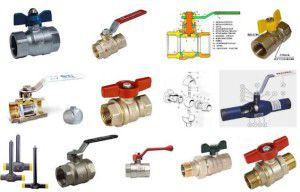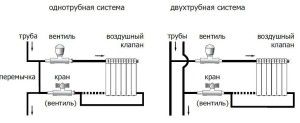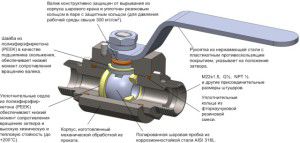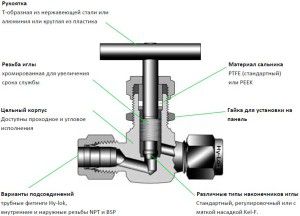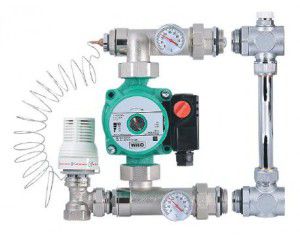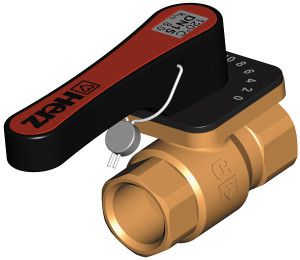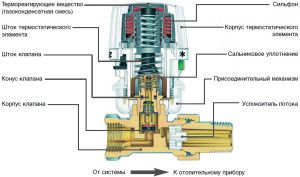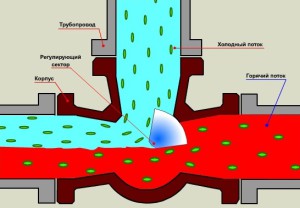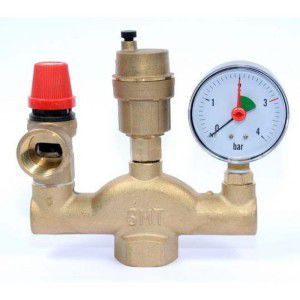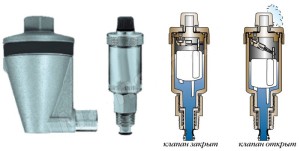The heating system is not possible without additional components. In addition to heating and distributing hot water on radiators, devices are needed to partially or completely cut off the coolant supply in certain sections of the circuit. For this, taps are installed in the heating system: three-way, ball, batteries and radiator.
The main functional tasks of faucets for heating
When designing a heating system, it is necessary to provide mechanisms for controlling the movement of hot water in the system. To do this, use a balancing valve in the heating system and its shutoff analog.
Despite the similar design, some types of valves can perform various functions. So ball polypropylene valves for heating can be designed both for emergency shutdown of hot water supply in a certain section of the highway, and for regulating the volume of fluid entering the radiator. Therefore, these components of heat supply are conventionally divided into the following types:
- For pipelines. In addition to restricting the flow of coolant, a two-way faucet for heating performs the function of mixing hot and cold flows. This is necessary to optimize the heat distribution;
- Tying boilers. To do this, they must use a valve to release air from the heating system, ball valves. In some cases, the installation of three-way mixers is recommended;
- For batteries. Without fail, in the piping of radiators, a Mayevsky crane is installed for heating. It is designed to remove air jams while filling the system with coolant.
In addition to the above valves, additional components can be installed in the heating system. They are necessary to improve the operation of heat supply and maximize automation of control. In particular, for the rapid removal of water from the system, a crane is needed to drain the water from the heating system. It is installed at the lowest point in the system.
Before purchasing valves, it is necessary to calculate its operational technical parameters. For this, it is best to use specialized software systems.
Shutoff valves for heat supply
All taps for radiators and pipelines work according to the general principle - with the help of a shut-off element they restrict the flow of coolant in a particular section of pipelines. However, the speed and degree of adjustment of this process depend on the specific design of the shutoff valves.
First of all, for the correct operation of the system, taps for radiators are needed. Depending on the design of the locking element, they are divided into two types:
- Ball;
- Needle
It must be remembered that during the operation of heat supply, situations may arise when it is necessary to completely limit the flow of coolant into radiators or a section of the pipeline. Ball valves are designed for this. If you need a smooth adjustment of the volume of incoming fluid - set needle valves.
Control valves for heating are characterized not only by size and design data. A great influence on the term and quality of their service is exerted by the materials of manufacture.
Ball Valves
If it is necessary to quickly shut off water, install ball valves in the radiator or pipe section.Their design consists of a spherical core in which there is a through hole. It is connected to the control handle, through which the component is operated.
Depending on the material of manufacture, you can install the ball polypropylene valve for heating or its steel counterpart. It all depends on the heat supply area where it will be installed. In addition to this factor, when choosing, you need to consider the type of connection. It can be designed for taps of radiators or pipelines:
- Flange. They are used in medium and large diameters. Mostly made of steel, its alloys or cast iron;
- Coupling. The most common type of ball polypropylene valves for heat supply. Connection to the pipe section is due to one-piece connection or by soldering. Adhesive is rarely used to form the assembly.
These taps for heating pipes are characterized by a quick shutdown of the coolant. It is enough to turn the control handle 90 ° to completely stop the movement of water in the section of the highway or radiator.
During installation, the direction of movement of the coolant must be taken into account. All ball plastic valves for heating have a special pointer on the body.
Needle cranes
If a smooth adjustment of the fluid flow is necessary, installation of needle taps for heating should be provided in the heat supply system. Their main difference from the ball is the presence of a rod, which with the help of a threaded mechanism lowers or rises, thereby reducing the throughput in this section of the pipeline.
Depending on the field of application, this type of valve can be shut-off, adjusting or balancing. The difference in design is determined by the shape of the needle rod, the characteristics of the threaded control element. Most faucets for heating radiators have a standard design and are designed for smooth adjustment of the flow of coolant.
When choosing, it is recommended to pay attention to the following characteristics of needle fittings for heat supply:
- Type of connection - coupling or flange;
- The degree of adjustment of the position of the rod;
- The material of manufacture. In polypropylene pipes, installation of plastic faucets for heating is mandatory. If steel lines are installed in the system, then stop valves should be selected from the same manufacturing material. This will avoid the difference in thermal expansion of the components.
The use of these structures as taps for draining water from a heating system is not recommended. In this case, ball models are the best option.
All valves for heat supply batteries are designed for a specific indicator of maximum and optimal pressure. This characteristic should correspond to the calculated one. Otherwise, depressurization of the system will occur.
Mixing devices
For optimal heat supply, heating control valves are installed. Their main difference from the above models is the presence of an automatic unit for adjusting the flow of water. Such designs are most often installed in mixing units.
Such types of valves differ from standard valves by the presence of additional control elements, as well as by the number of connected branch pipes. The standard three-way faucet for heating has three connecting pipes. In addition, each of them performs its functions:
To select the optimal model, you should decide on its purpose, which can be of the following types:
- Organization of automatic regulation of fluid flow to a radiator or battery. For this, a two-way faucet is designed for heating;
- Mixing unit installation. For him, three-way taps for heating are most often used.
To understand the principle of operation of each of them, you must first understand the specifics of the design. It determines the operational and technical characteristics of these heating components.
For the three-way control valve to work properly, a thermometer must be connected to its control unit.
Two way heating tap
In fact, this is a regular needle valve, in which, instead of a mechanical valve, a block for automatically changing the position of the rod is installed. It is designed to bundle heat supply batteries. To be able to respond to the degree of heating of the device, each radiator must be equipped with a heating control valve.
There is a separation of models by type of control unit. The most common type of two-way faucet for heating is a thermostat. It has a control element that expands under the influence of temperature. During this process, the rod moves, thereby changing the throughput in this section of the pipe. Such designs are installed for heating radiators.
However, there is not always a need for such taps for heating pipes. Depending on the required level of regulation, the following types of two-way heating components are distinguished:
- With mechanical control unit. Markings are applied on it, corresponding to the degree of change in the conditional passage in the pipe. Convenient for manual heating control;
- Servo mechanism with the ability to connect to temperature sensors or a programmer. These control valves for heating are characterized by maximum control automation.
When choosing, it is important to pay attention to the design of the control drives. They can be two positional (open-closed) or with a smooth change in the position of the stem. It all depends on the purpose of the two-way valve for heat supply.
Similar control structures are installed in the collectors for automatic control of the flow of coolant. They have proven themselves in the presence of flow meters.
Three-way valve for heat supply
One of the types of heat supply control valves is a three-way design. Their main difference from the above models is the presence of an additional pipe.
For operation, a three-way valve is connected to the supply and return pipes. With the help of the control unit, the position of the valve is changed, thereby regulating the flow of chilled fluid into the supply pipe. This principle of operation allows you to solve the following tasks:
- Reduced heating fluid heating costs. The temperature sensors connected to the control units of the plastic taps for heat supply automatically change the heating mode depending on external factors;
- System pressure stabilization. In the case of a large difference in the degree of expansion of water will increase the hydraulic resistance. Installation of a balancing tap in the heating system will solve this problem;
- Automatic regulation of thermal conditions heating circuits depending on previously configured parameters.
The choice of control units for the device is completely analogous to two-way valves for heat supply pipes. The difference is only in the form of a flow control element. If in two-way it is a rod, then in three-way models use a special plate. Depending on its position, the quantitative ratio of hot and cold flows changes.
To complete the heating system, it is best to use copper models of mixing taps. But the best choice would be products made of stainless steel.
Management and safety of heating
In addition to the regulatory function, there is a group of faucets that are responsible for the protection and control of heating. They are installed in important areas of the system - in the supply pipes, radiators and batteries. In particular, a faucet for venting air from the heating system is mounted directly after the boiler. In collector heat supply, each distribution comb must be equipped with it.
These system components are required to perform the following functions:
- Air removal at an overheat of the heat carrier;
- Prevent air jams in the radiator or battery.
To fully understand the functional features of security groups, you need to consider the design of each element.
Some gas boiler models have built-in balancing valves. Their presence can be ascertained from the contents of the accompanying documentation.
Description of the Mayevsky crane
Mayevsky taps for heating are designed to remove air jams while filling the system with coolant or during operation of the heat supply. They are a conical screw, which is enclosed in a housing.
The installation location of this tap is the top of the radiator. When adding water to the system, it is necessary to reduce the pressure of the spring on the screw. Thus, a small passage is formed through which the air plug exits. Depending on the specific design, the Mayevsky crane can be of the following types:
- Mechanical. Adjustment is carried out in manual mode;
- Auto. A special device is initiated by opening the valve. As a result, the air plug is removed.
To complete the heating, the first type of faucets is most often used. However, they have one significant drawback. With prolonged downtime, the screw sticks to the base of the case. Therefore, it is recommended to check the operability of the crane 2-3 times a season, regardless of whether the system is filled with water or not.
For centralized heating systems, it is best to choose a Mayevsky faucet model with a fuse.
Air vent
Often air accumulates in the heating system. There are several reasons for its appearance - boiling water, initially a high oxygen content in the liquid. If the excess air is not removed in time, then the heat supply components may suffer, and metal elements will begin to rust. It can also lead to an increase in pressure and, as a consequence, to the creation of emergency situations.
Structurally, the valve for removing air from the system consists of a body, inside which a float is placed. If air enters the cavity, the float rises, which will press on the rod. This will provoke the opening of the valve and the release of excess gas.
When choosing and installing, you need to consider the following points:
- Nominal response pressure of the device. It can be installed by the user or be fixed;
- Place of installation. A mandatory element for a security group, where in addition to it there must be a drain valve and a manometer. It is mounted immediately after the boiler, the upper part of the circuit and in all critical sections of the highway.
Before every heating season, it is imperative to check the air vent's performance. To do this, it is enough to manually raise the valve and make sure that it is not stuck.
Each type of heating tap has its own purpose. But you need to remember that some of them are interchangeable. Exceptions are only air vents and Mayevsky taps. In all other cases, you can install a needle instead of a ball.
In the video material you can get acquainted with the principle of the design of the three-way heating tap;
